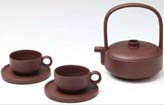Chinese Way
A peek into world of basement treasures
Updated: 2011-08-25 07:44
By Cheng Yingqi (China Daily)
The Palace Museum's vast display of paintings, calligraphy and ceramics actually account for less than 1 percent of its collection.
"The exhibits cover not even 1 percent because it is neither necessary nor possible for the museum to show everything to the public. We are not running an antique stall. We only display items that relate to a certain theme," says Gao He, former director of the storage department of the Palace Museum.
Gao says, while the museum does not have the space to display all the artifacts, some relics such as paintings and textiles are too fragile to be exposed for a long time.
So, where are 99 percent of the relics kept?
"Many believe the museum has some mysterious storage place. But even those who have worked here at the museum have no idea about it," Gao says.
Since the museum only allows professionals involved with relics protection to enter the storage area, few have glimpsed these treasures.
Gao is one of the lucky few to have seen them.
Located in the western part of the Forbidden City, not open to the public, is the entrance to a huge basement area and it is here that the treasures are kept.
Although the museum came up with the idea of building the basement as early as 1982, construction did not begin until 1987, pending extensive geological examination of the underground area. And it was only in 1997 that the 22,000 square meter basement was finally ready.
The three-story basement has reinforced concrete structures, is covered in waterproof materials and equipped with fumigation devices. The inside temperature is kept stable between 14.5 C and 16.5 C.
According to Gao, before being transferred to the basement, most of the relics were kept in dilapidated old buildings that could not even guarantee their safety, let alone their preservation.
"In the basement, the relics are carefully stored, with enough space and shockproof materials between items," Gao says.
"We even agonized over whether it was safe to build a restroom in the basement. Eventually, we decided against it as any plumbing problems would ruin the relics," he says.
Gao reveals that only about 60 percent of the treasures have been moved to the basement.
"Some relics are not so fragile that they need such strict care and some, like furniture, are hard to move," Gao says.
Currently, only 27,000 square meters of the royal palace's 155,000 square meters is open to the public, and those relics that are not in the basement remain in these closed-off areas.
"The basement is equipped with state-of-the-art technology," says Pan Shouyong, a professor from Minzu University of China.
"Once the doors are shut, the automatic air circulation system will cut off within 20 minutes," he says.
Pan says light, dust, heat and moisture are all risk factors, hence the air circulation system is designed to guard against these as much as against theft.
Although the basement treasures are not open to the general public, they can be accessed by researchers with special permission, who may see or take pictures of them.
"Whether you are a well-known expert or a high ranking official, you cannot touch these items, only the museum professionals can," Gao says.
"No one can cite his privileged status to take away any of the relics," professor Pan says.

Specials

Biden Visits China
US Vice-President Joe Biden visits China August 17-22.

Star journalist leaves legacy
Li Xing, China Daily's assistant editor-in-chief and veteran columnist, died of a cerebral hemorrhage on Aug 7 in Washington DC, US.

Hot pots
Tea-making treasures catch the fancy of connoisseurs as record prices brew up interest